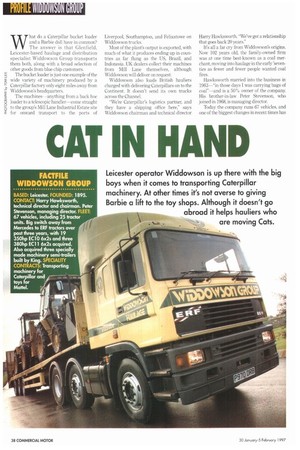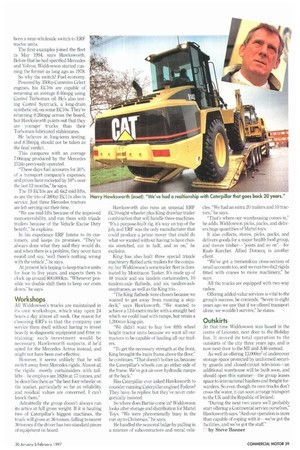W hat do a Caterpillar bucket loader and a Barbie doll
Page 40

Page 41

If you've noticed an error in this article please click here to report it so we can fix it.
have in common? The answer is that Glenfield, Leicester-based haulage and distribution specialist Widdowson Group transports them both, along with a broad selection of other goods from blue-chip customers.
The bucket loader is just one example of the wide variety of machinery produced by a Caterpillar factory only eight miles away from Widdowson's headquarters.
The machines—anything from a back hoe loader to a telescopic handler—come straight to the group's Mill Lane Industrial Estate site for onward transport to the ports of Liverpool, Southampton, and Felixstowe on Widdowson trucks.
Most of the plant's output is exported, with much of what it produces ending up in countries as far flung as the US, Brazil, and Indonesia. UK dealers collect their machines from Mill Lane themselves, although Widdowson will deliver on request.
Widdowson also loads British hauliers charged with delivering Caterpillars on to the Continent. It doesn't send its own trucks across the Channel.
"We're Caterpillar's logistics partner, and they have a shipping office here," says Widdowson chairman and technical director Harry Hawksworth. "We've got a relationship that goes back 20 years."
It's all a far cry from Widdowson's origins. Now 102 years old, the family-owned firm was at one time best-known as a coal merchant, moving into haulage in the early 'seventies as fewer and fewer people wanted coal fires.
Hawksworth married into the business in 1963—"in those days I was carrying bags of coal"—and is a 50% owner of the company. His brother-in-law Peter Stevenson, who joined in 1968, is managing director.
Today the company runs 67 vehicles, and one of the biggest changes in recent times has been a near-wholesale switch to ERF tractor units.
The first examples joined the fleet hi May 1.994, says Hawksworth. Before that he had specified Mercedes and Volvos; Widdowson started running the former as long ago as 1978.
So why the switch? Fuel economy.
Powered by 350hp Cummins Celect engines, his EClOs are capable of returning an average 8.46mpg using Castro] Turbotnax oil. He's also testing Castrol Syntruck, a long-drain synthetic oil, on some EClOs. They're returning 826mpg across the hoard, but Hawksworth points out that they are younger trucks than their Turbomax-lubricated stablemates.
He believes in long-term testing, and 8.26mpg should not be taken as the final verdict.
This compares with an average 7.06mpg produced by the Mercedes 2534s previously operated.
"These days fuel accounts for 30% of a transport company's expenses, and prices have rocketed by 10% over the last 12 months," he says.
The 19 EClOs are all 6x2 as are the trio of 380hp EClis also in service. Just three Mercedes tractors are left serving out their time.
"We use mid-lifts because of the improved manoeuvrability, and run them with triaxle trailers because of the Vehicle Excise Duty benefit," he explains.
In his experience ERF listens to its customers, and keeps its promises. "They've always done what they said they would do, and when there is a problem, they never turn round and say, well there's nothing wrong with the vehicle'," he says.
At present he's hoping to keep tractor units for four to five years, and expects them to clock up around 800,000km. "Whenever possible we double shift them to keep our costs down." he says.
All Widdowson's trucks are maintained in its own workshops, which stay open 24 hours a day almost all week, One reason for choosing ERFs is that the company can service them itself without having to invest heavily in diagnostic equipment and fitter retraining; such investment would be necessary, Hawksworth suspects, if he'd opted for the Mercedes Actros instead, and might not have been cost-effective.
However, it seems unlikely that he will switch away from Mercedes rigids. Almost all the rigids-mostly curtainsiders with tailliftshe employs are 1820s at 17 tonnes, and he describes them as "the best four-wheeler on the market, particularly so far as reliability and residual values are concerned. I can't knock them."
Admittedly the group doesn't always run its artics at full gross weight. If it is hauling two of Caterpillar's biggest machines, the truck will gross at 36 tonnes. falling to nearer 30 tonnes if the driver has two standard pieces of equipment on board. Hawksworth also runs an unusual ERF EC10 eight-wheeler plus King drawbar trailer combination that will handle three machines. "It's a purpose-built rig, it's way on top of the job, and ERF was the only manufacturer that could produce a prime mover that could do what we wanted without having to have chassis stretched, cut in half, and so on," he explains.
King has also built three special triaxle machinery flatbed artic trailers for the company. but Widdowson's semi-trailer fleet is dominated by Montracon Tasker. It's made up of 48 triaxle and six tandem curtainsiders, 10 tandem-axle flatbeds, and six tandem-axle stepframes, as well as the King trio.
"The King flatbeds were chosen because we wanted to get away from running a stepdeck," says Hawksworth. We wanted to achieve a 13.6-metre trailer with a straight bed which we could load with ramps, but retain a 1,200mm king-pin, "We didn't want to buy low fifth wheel height tractor units because we want all our tractors to be capable of hauling all our trailers.
"lb get the necessary strength at the front, King brought the main frame above the floor," he continues. "That doesn't bother us, because the Caterpillar's wheels can go either side of the frame. We've got air-over-hydraulic ramps at the back," Has Caterpillar ever asked Hawksworth to consider running Caterpillar-engined Fodens? They have, he replies: but they've never categorically insisted.
So where does Barbie come in? Widdowson looks after storage and distribution for Mattel lbys. "We were phenomenally busy in the run-up to Christmas," he says.
He handled the seasonal bulge by pulling in a mixture of subcontractors and rental vehi
cies. "We had an extra 20 trailers and 10 tractors:' he says.
"That's where our warehousing comes in," he adds. Widdowson picks, packs, and delivers huge quantities of Mattel toys.
It also collects, stores, picks, packs, and delivers goods for a major health food group, and moves timber—"joists and so on" for Raab Karcher. Allied Domecq is another client.
"We've got a tremendous cross-section of small accounts too, and we run two 6x2 rigids fitted with cranes to move machinery," he says.
All the trucks are equipped with two-way radios.
Offering added-value services is vital to the group's success, he contends, "Seven to eight years ago we saw that if we offered transport alone, we wouldn't survive," he states.
Outskirts
At that rime Widdowson was based in the centre of Leicester, next door to the Holiday Inn. It moved its total operation to the outskirts of the city three years ago, and is now next door to the M1 and A46 instead.
As well as offering 13,000m2 of undercover storage space protected by uniformed security guards and closed-circuit television—an additional warehouse will be built soon, and should open this summer-the group leases space to international hauliers and freight forwarders. So even though its own trucks don't cross the water, it can soon arrange transport to the UK and the Republic of Ireland.
"During the next two years we'll probably start offering a Continental service ourselves," Hawksworth says. "And our operation is more than capable of coping with it—we've got the facilities, and we've got the staff."
P. by Steve Banner








































































































